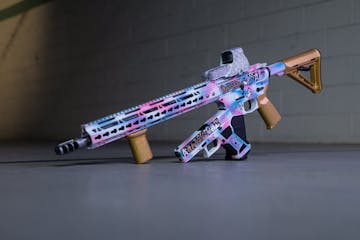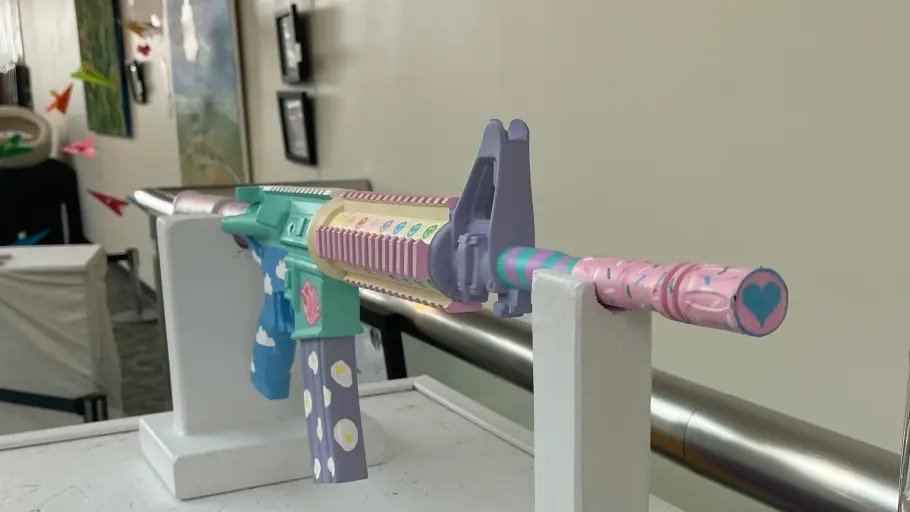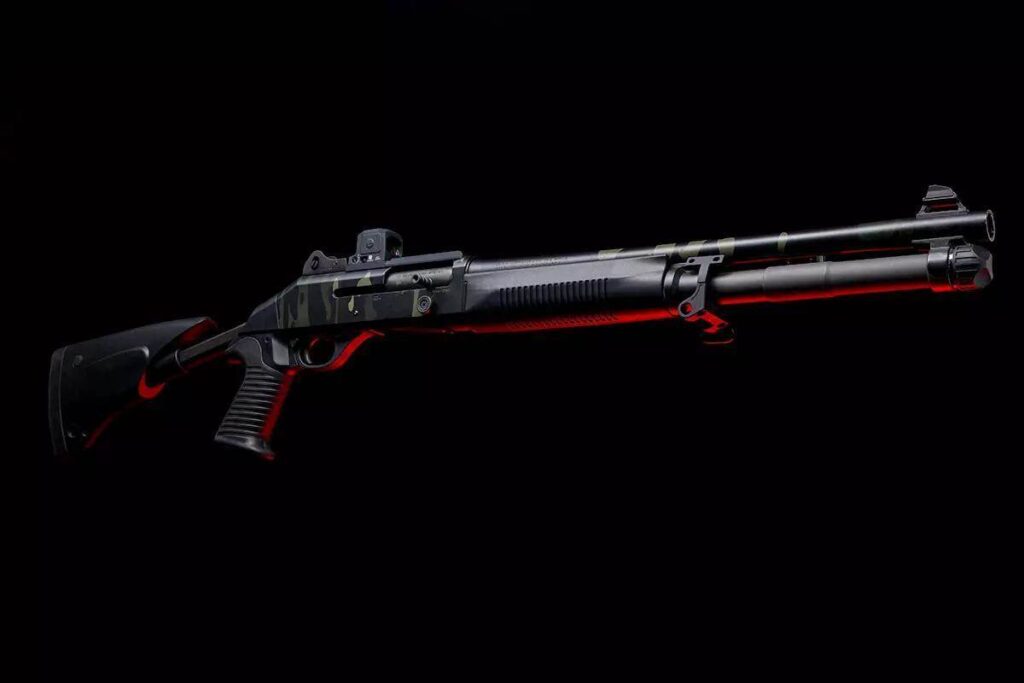A troubling current trend in the wake of any tragedy involving firearms and violence is to mock and belittle those who offer their thoughts, prayers, condolences, and even open their personal resources to help the victims and community. Unless you are rapidly attacking the very existence of firearms and proposing absurdly impractical solutions to solving the complex equations of violent motivations, you aren’t doing enough.
But those impractical and entirely unworkable solutions, along with most efforts to bring “awareness” to the violence (believe us, everyone knows), are just another spin on the same idea. We are sorry this even happened, we do not like that it happened, we want to support the victims… thoughts and prayers.
So, to ArtPrize we go… (A delightful interactive Art Exhibition in Grand Rapids, Michigan if you weren’t aware)
Advertisement — Continue Reading Below
GRAND RAPIDS, Mich. (WOOD) — Moved by the Uvalde, Texas, school shooting in May, a Danish artist decided she would create a piece for ArtPrize that illustrates the number of lives lost in mass shootings in the U.S.
Fair, it is a topic we are bombarded with comparative to its risk for a number of reasons. The most sickening being that the clicks sell, they generate traffic to the sources covering the horrific event. It isn’t that we cannot or should not cover a horrific event, but the attention has a distinct negative effect too when it is a deliberately caused event. This is an unavoidable negative consequence of our largely open information system.
Publicity fuels these particular type of dangerous people. This pastel modeled AR-15 and its pile of rounds representing the slain will fall into the evil amalgamation of motivational forces that drive these terrifying killers. Someone, someday, somewhere, will want to add to that total. That isn’t a normal, moral, or rational thought, but it is going to be one someone has sometime in the future. There is dickall we can do to stop that thought from forming and being acted upon, we can only disincentivize it. We can only make it cost too much, to be worth too little, and we cannot possibly make it too costly or too worthless for every evil person.
Advertisement — Continue Reading Below
There is value in life… and therefore there is value in taking life.
“We heard a lot about that in Denmark and about the statistics…,” Junette Bay, the artist behind “The right to bear cute arms,” said. “…I read a lot about mass shootings in America and I heard a lot from podcasts and about how many weapons there is here.”
I would be curious to hear and read these sources.
Advertisement — Continue Reading Below
Which ones are more emotive hot take versus the far less emotive data from which we try and make best practices, policy and response improvements, search for better indicators, and any number of other things we and try and do to generate positive outcome interventions earlier and prior to an event. What we constantly fail to acknowledge is that this isn’t just a herculean task, it is impossible without removing human free agency entirely. Media and LE sources have been focusing heavily on any stopped event than can, due to the very toxic public perception of law enforcement ineptitude after Uvalde.
We can’t switch off evil (minus ballistically under very specific legal circumstances). We can’t get people to return their shopping carts, an act that costs nearly no effort and provides the small reward of knowing you helped the staff of the establishment, and yet we seem to believe
Bay is a designer, muralist and street artist in Denmark. She said that her ArtPrize entry is “very different” than what she normally does.
Advertisement — Continue Reading Below
“The art that I do is very cheerful. I use pastel colors and patterns and people always tell me that it is very uplifting to look at my art. But when I heard about this happening in America, I felt that I was not going to do a piece that was going to be uplifting. So I wanted to do something a little more serious,” Bay said.
“Serious” art, something looking to generate a darker introspection, takes a tremendous amount of effort, not least of which comes from the context of the art and the context viewers bring to the art. Some art works in that regard very well, viewers perspectives help shape their experience in the viewing but they all grow with the experience.
This, by contrast, well…
Advertisement — Continue Reading Below
During her research, she said she wanted to depict an AR-15 because “it is the most commonly used for mass shootings.”
It is not. Handguns are. By a substantial margin…
So here, in her carefully researched work from Denmark via podcasts and the internet, she already has failed her viewers and herself in trying to depict the costs of violence upon the innocent. She has taken inaccurate information, easily verifiable, and used it within her messaging. So to her viewers who know better, she is lying or ignorant. To her viewers who do not know better, she is spreading false information and making them ignorant liars by proxy.
Advertisement — Continue Reading Below
And if the counter argument to that is, “Well this is art. It’s really only to make you feel a certain way. Make you think, you know?”
Oh? Make me think? To generate thoughts and pray we come up with a solution? That is a noble effort, except the piece is actively mocking what it is itself doing. Perhaps she only means the thoughts and prayers of politicians, which I would concur are often as worthless as their promises, and if so I think that message gets lost in the overgeneralization.
Perhaps she could take specific statements from politco types over the various events and point those out specifically, not mock everyone who feels sorry the community who is hurting by telling them they aren’t helping right, followed up by doing nothing particularly useful yourself because you don’t know any better solution either.
Advertisement — Continue Reading Below
“I tried to get a replica from Denmark but that is not possible. So I ordered a replica from a California company that (makes) props for the movie industry,” Bay said.

She painted the replica AR-15 with her signature style of pastels and patterns. She said the contrast between the cheerful colors and childlike patterns and the deadly weapon gave her a constant knot in her stomach.
Advertisement — Continue Reading Below
This comment, not a quote but a comment within the story, feels like hyperbole. Some of the same we’ve seen around the AR-15 before when trying to describe its destructive capabilities in ludicrous fashion. PTSD inducing effects… in a rifle that a six year old can fire without discomfort.
“I was feeling sick really because the light and cheerful colors and the object that is designed for killing, combining theses two, just feels so wrong,” Bay said.
Umm.. yours is fake… these are not.




Bright colors were embraced by the firearms community for fun a long time ago. This color scheme is far from an original concept and has been done repeatedly upon working firearms, some even that parents have done for their children to making shooting a more fun experience for them.
Because shooting is fun, is safe, and can be learned in a safe manner as children mature and learn other safe practices. This has been done for centuries now.
Along with the AR-15, the Danish artist created 3D printed bullets, each one representing a different mass shooting that has happened in the U.S. this year. As of Sept. 19, there were 573. The bullets have the words “thoughts and prayers” on them.
If you couldn’t tell, this is where the art project really fell off the track for me. Mocking thoughts and prayers with an art exhibit that is nothing more than something to provoke thought and praying it will ‘trigger meaningful change’ or some other such lofty ‘goal’ that doesn’t translate well into policy, mental health awareness, criminal prosecution practices, or any of the other myriad topics that influence rates of stress triggered violence, recidivism, criminal mischief, extreme sadism elements, and all the other influences that combine to form a violent outburst seems unproductive too.
People insist upon treating gun crime like it is this linear item we can do very simple things about, when it’s more like watching for natural disasters forming by reading as much sign as we can.
A mass shooter is a tornado, a wildfire, a hurricane in human skin, except we have exceptionally more superior tools for tracking weather effects and atmospherics (and still get it wrong on the daily) and we’re nowhere near to being able to track the emotional atmospherics of a person, to say nothing of 330,000,000 of them (for the US) or 7,000,000,000 globally.
Especially if they are motivated to hide problems, which they are.
“(These) words are used a lot here, and these are just words. It doesn’t seem like there is any action behind the words,” she said.
Like making a brightly colored AR replica might be an image worth thousands of words, but it isn’t delving into motives, causes, multi-tiered effects of policy decisions, and other things that take the problem on in a more direct manner? Because those are hard? Because those don’t always have nice clean answers? Because those don’t always end in an ‘answer’ at all?
She said she’s excited to hear people’s arguments for and against guns as well as their personal experiences. Since installing her artwork at the DeVos Place Convention Center, she said she has received a lot of feedback from visitors.
“I’ve seen some of the reactions and some of them almost made me cry,” Bay said. “There was some teachers coming up to me and saying, ‘Thank you for doing this,’ and also younger people are thanking me.”
That is fantastic that the piece is garnering attention and generating a dialogue, those fall into the thought category of thoughts and prayers. The question remains does anyone have a good idea on what to do now?
I do mean a good idea, one that has been thought out to its second and third order effects. The realistic likely effects of the policy or policies and their positive and negative outcomes, possible or probable consequences, and any unintended consequences that can be speculated on like the opening of additional illegal market spaces to compensate for a demand.
In short, this is nothing that will be solved by abstract art and people agreeing that violence against children is a bad thing. It doesn’t make the exhibit bad, or wrong, or useless, but it isn’t anything more than another form of condolences.















